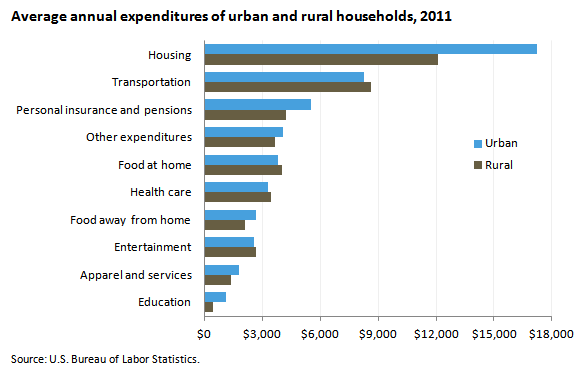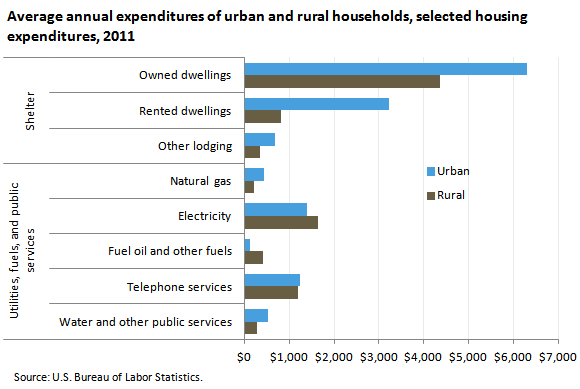An official website of the United States government
 United States Department of Labor
United States Department of Labor
In 2011, urban households spent $50,348, which was 18 percent more than the $42,540 spent by rural households. Urban households had higher expenditures on food, housing, apparel, and education, while rural households spent more on transportation, health care, and entertainment.

| Item | Urban | Rural |
|---|---|---|
Average annual expenditures | $50,348 | $42,540 |
Housing | 17,226 | 12,115 |
Transportation | 8,266 | 8,606 |
Personal insurance and pensions | 5,533 | 4,201 |
Other expenditures | 4,086 | 3,653 |
Food at home | 3,824 | 4,013 |
Health care | 3,303 | 3,426 |
Food away from home | 2,665 | 2,077 |
Entertainment | 2,566 | 2,652 |
Apparel and services | 1,771 | 1,371 |
Education | 1,107 | 425 |
Urban households spent $17,226 on housing in 2011, more than they spent on clothing, transportation, health care, and entertainment combined.
In the transportation category, spending differs by less than $400 between urban and rural households and the types of transportation expenditures vary greatly. In 2011, urban and rural households spent an average of $2,586 and $2,817, respectively, on new and used cars and trucks. Rural households spent $3,115 on gasoline and motor oil, compared with the $2,613 spent by urban households. But urban households spent more on other categories, such as airline fares ($360 compared with $137).
Urban households spent about $200 less than rural households on food at home, but spent about $600 more on food away from home, including meals at restaurants, meals at carry outs, and food on out-of-town trips.
In 2011, rural households reported spending $2,652 on entertainment, only $86 more than urban households. However, a major difference in entertainment spending can be found in the fees and admissions category, with urban households reporting expenditures of $621 per year, on average, and rural households reporting expenditures of $299.
Urban households were two times more likely to rent than rural households, and urban households spent $2,404 more on rented dwellings per year in 2011. Though urban households were less likely to be homeowners than rural households, they spent $1,946 more on owned homes per year.

| Item | Urban | Rural |
|---|---|---|
Shelter | $10,211 | $5,529 |
Owned dwellings | 6,308 | 4,362 |
Rented dwellings | 3,228 | 824 |
Other lodging | 675 | 343 |
Utilities, fuels, and public services | 3,723 | 3,766 |
Natural gas | 438 | 213 |
Electricity | 1,403 | 1,648 |
Fuel oil and other fuels | 133 | 423 |
Telephone services | 1,230 | 1,192 |
Water and other public services | 520 | 290 |
Urban households spent more on natural gas, $438 to $213, and water and other public services, $520 to $290, respectively, while rural households spent more than urban households on fuel oil and other fuels, $423 to $133, respectively.
These data are from the Consumer Expenditure Survey and are featured in “Expenditures of urban and rural households in 2011,” (PDF) Beyond the Numbers, February 2013. The Consumer Expenditure Survey defines urban households as all households living inside a metropolitan statistical Area (MSA) plus households living in urban areas even if they are outside of an MSA.
Bureau of Labor Statistics, U.S. Department of Labor, The Economics Daily, Expenditures of urban and rural households in 2011 at https://www.bls.gov/opub/ted/2013/ted_20130301.htm (visited January 07, 2026).

